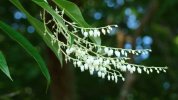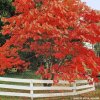Sourwood trees have lots of interesting attributes... they are the only tree in their genus, Oxydendrum, and they also are only native to North America. While they can be found from North Florida to Southern Pennsylvania, they tend to grow best in the lower Appalachian mountain range.
View attachment 35162
They typically flower in early summer well after many other trees have bloomed, with small white bell-shaped flowers similar to lily of the valley flowers.
View attachment 35163
They also have strikingly red foliage in the fall as their green leaves turn red.
View attachment 35164
What they are REALLY prized for, though, is their honey! It's exceptionally good, and with a unique flavor profile that makes it stand out among other more muted honey flavors. The honey is also unique in the harvesting time, again due to flowering later than most other earlier spring plants/trees. Growing up in South Carolina my family always made it a point to buy a jar or two when visiting the NC mountains on quick vacations.
Sure wish I had a stand on my place. From what I've read, they aren't the easiest tree to grow/establish, as they like rather acidic soils and their very fine roots don't handle compaction well.
Lots of very informative articles about them online.



